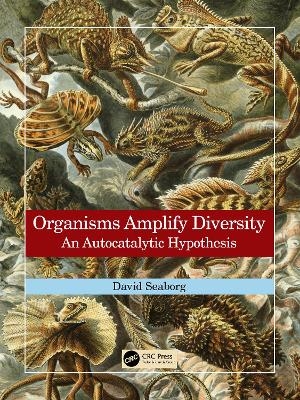
Organisms Amplify Diversity
CRC Press (Verlag)
978-1-032-15802-0 (ISBN)
- Titel z.Zt. nicht lieferbar
- Versandkostenfrei innerhalb Deutschlands
- Auch auf Rechnung
- Verfügbarkeit in der Filiale vor Ort prüfen
- Artikel merken
Key Features
Life alters the Earth in ways that increase biodiversity
All species make their environment better for other species and promote diversity
Life created the life-friendly atmosphere, temperature, and soil of today
David Seaborg is a renowned evolutionary biologist. He originated the concept that organisms act as feedback systems with respect to their evolution, and that they thus play an important role in guiding their evolution. This concept is a mechanism for punctuated equilibrium. He showed that the standard genetic code is on an adaptive peak, and how populations cross over maladaptive valleys from one adaptive peak to another. He published a hypothesis to explain how homosexuality evolved even though it theoretically reduces the number of offspring produced. He wrote an article on the serious non-climatic effects of excess carbon in the atmosphere. He wrote two books on his influential Autocatalytic Biodiversity Hypothesis, which proposes that all species help their ecosystem and other species, and increase biodiversity, in natural ecosystems. He has taught biology from kindergarten to the university level. He founded and is President of the World Rainforest Fund, a nonprofit, tax exempt foundation dedicated to saving the Earth’s tropical rainforests and biodiversity by empowering the indigenous people who live in rainforests. David conceived the idea for and organized a press conference of Nobel Prize winners on global environmental issues held at the 100th Nobel Prize ceremonies in Stockholm in 2001.
Chapter 1. Introduction
Chapter 2. Life Regulates the Atmosphere’s Greenhouse Gas Levels and the Earth’s Temperature
Chapter 3. Organisms Created High Oxygen Levels, which Allowed Complex Life to Evolve and Diversify
Chapter 4. Species Profoundly Affect the Evolution of Other Species; Coevolution is Fundamentally Important and Was Involved in the Vast Majority of Major Evolutionary Transitions
Chapter 5. In Ecological Succession, Earlier Communities Create Favorable Environmental Conditions for Succeeding, Usually More Complex and Diverse, Communities
Chapter 6. Life Creates Soil, a Diverse Ecosystem that Benefits Life in the Soil and Above It
Chapter 7. Eukaryotes are Complex Ecosystems with Diverse Microbiomes, Showing the Importance of Symbiosis and Commensalism, and Challenging the Concept of the Individual
Chapter 8. Viruses Are by Far the Most Genetically Variable and Biodiverse Group of Organisms, Generate High Diversity in Cellular Organisms, and Are Key Drivers of Major Adaptive Macroevolutionary Breakthroughs in Cellular Organisms
Chapter 9. Genomes and Their Behaviors Promote Genetic Variability, Evolution, Large Adaptive Evolutionary Innovations, and Diversification; the Amount and Nature of Genetic Variability is Subject to Natural Selection
Chapter 10. Altruism and Cooperation within Populations Are Often Adaptive, and Maintain Populations and Diversity
Chapter 11. Network Theory Models and Empirical Evidence Support the Thesis that Coevolved Diversity and Connectance Correlate with Ecosystem Stability, Productivity, Resilience, and Persistence
Chapter 12. Scientific Laws Indicate the Essential Inevitability of the Chemical Evolution of Life Under Favorable Conditions; a Hypothesis that Incorporates the Autocatalytic Biodiversity Hypothesis Postulates a Tendency for Increase in Information in Systems with Favorable Conditions
Chapter 13. The Solar System, Sun, Jupiter, Earth’s Moon, and Nonbiological Earth All Aid Life, Suggesting the Autocatalytic Biodiversity Hypothesis Does Not Account for All of Earth’s Biodiversity, and is a Subset of a More General Hypothesis
Chapter 14. Counter Examples to and Arguments against the Autocatalytic Biodiversity Hypothesis and Answers to Them
Chapter 15. Implications
Glossary
Index
| Erscheinungsdatum | 11.07.2023 |
|---|---|
| Zusatzinfo | 1 Line drawings, black and white; 12 Halftones, black and white; 13 Illustrations, black and white |
| Verlagsort | London |
| Sprache | englisch |
| Maße | 210 x 280 mm |
| Gewicht | 1100 g |
| Themenwelt | Naturwissenschaften ► Biologie ► Botanik |
| Naturwissenschaften ► Biologie ► Ökologie / Naturschutz | |
| Naturwissenschaften ► Biologie ► Zoologie | |
| Weitere Fachgebiete ► Land- / Forstwirtschaft / Fischerei | |
| ISBN-10 | 1-032-15802-6 / 1032158026 |
| ISBN-13 | 978-1-032-15802-0 / 9781032158020 |
| Zustand | Neuware |
| Informationen gemäß Produktsicherheitsverordnung (GPSR) | |
| Haben Sie eine Frage zum Produkt? |
aus dem Bereich


